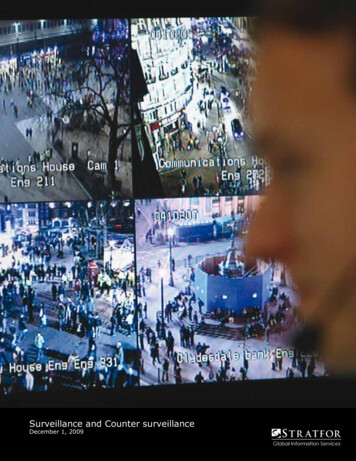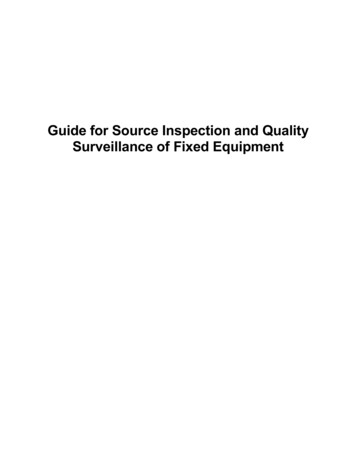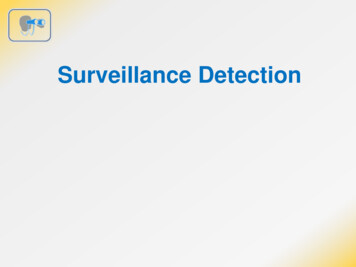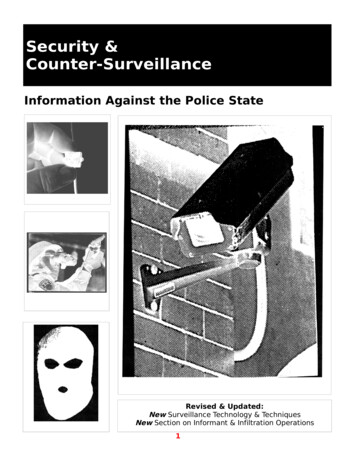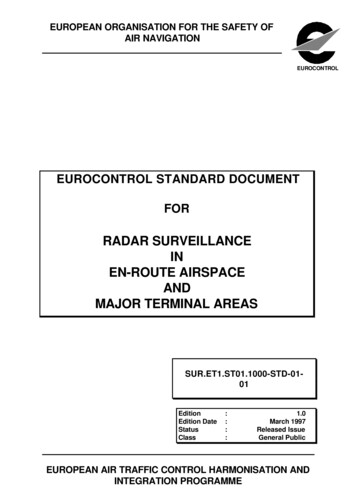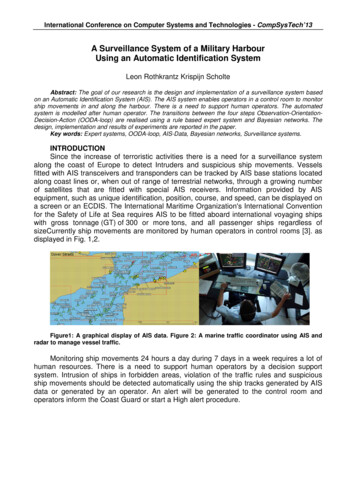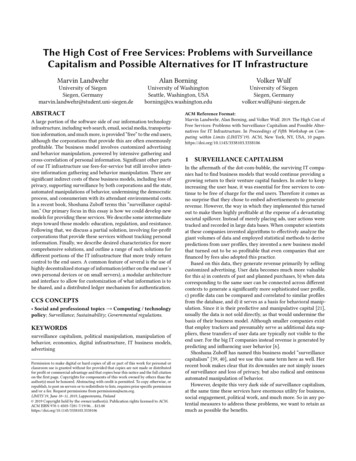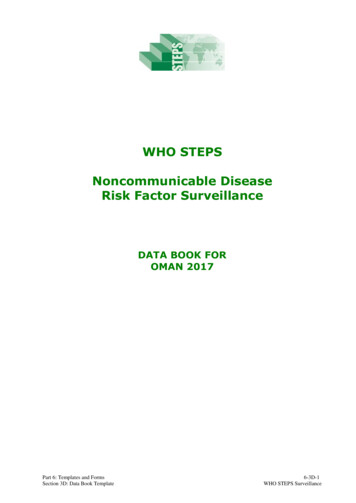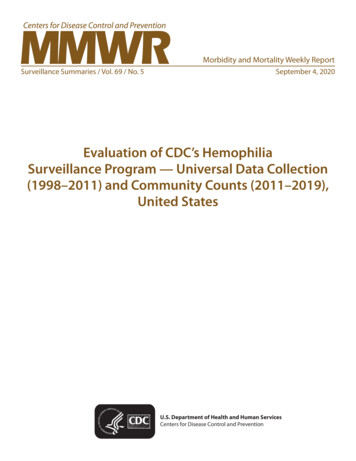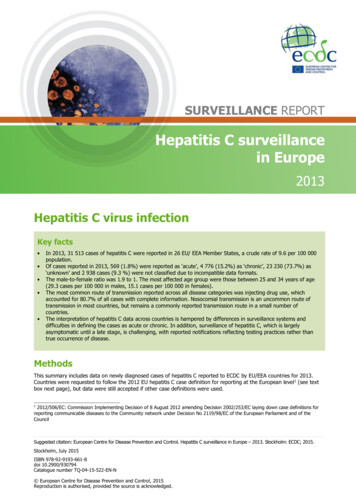
Transcription
SURVEILLANCE REPORTHepatitis C surveillancein Europe2013Hepatitis C virus infectionKey facts In 2013, 31 513 cases of hepatitis C were reported in 26 EU/ EEA Member States, a crude rate of 9.6 per 100 000population.Of cases reported in 2013, 569 (1.8%) were reported as ‘acute’, 4 776 (15.2%) as ‘chronic’, 23 230 (73.7%) as‘unknown’ and 2 938 cases (9.3 %) were not classified due to incompatible data formats.The male-to-female ratio was 1.9 to 1. The most affected age group were those between 25 and 34 years of age(29.3 cases per 100 000 in males, 15.1 cases per 100 000 in females).The most common route of transmission reported across all disease categories was injecting drug use, whichaccounted for 80.7% of all cases with complete information. Nosocomial transmission is an uncommon route oftransmission in most countries, but remains a commonly reported transmission route in a small number ofcountries.The interpretation of hepatitis C data across countries is hampered by differences in surveillance systems anddifficulties in defining the cases as acute or chronic. In addition, surveillance of hepatitis C, which is largelyasymptomatic until a late stage, is challenging, with reported notifications reflecting testing practices rather thantrue occurrence of disease.MethodsThis summary includes data on newly diagnosed cases of hepatitis C reported to ECDC by EU/EEA countries for 2013.Countries were requested to follow the 2012 EU hepatitis C case definition for reporting at the European level 1 (see textbox next page), but data were still accepted if other case definitions were used.12012/506/EC: Commission Implementing Decision of 8 August 2012 amending Decision 2002/253/EC laying down case definitions forreporting communicable diseases to the Community network under Decision No 2119/98/EC of the European Parliament and of theCouncilSuggested citation: European Centre for Disease Prevention and Control. Hepatitis C surveillance in Europe – 2013. Stockholm: ECDC; 2015.Stockholm, July 2015ISBN 978-92-9193-661-8doi 10.2900/930794Catalogue number TQ-04-15-522-EN-N European Centre for Disease Prevention and Control, 2015Reproduction is authorised, provided the source is acknowledged.
ECDC SURVEILLANCE REPORTHepatitis C surveillance in Europe, 20132012 EU case definition for hepatitis CClinical criteria: not relevant for surveillance purposesLaboratory criteria: At least one of the following three: Detection of hepatitis C virus nucleic acid (HCV RNA)Detection of hepatitis C virus specific antigen (HCV core)Hepatitis C virus specific antibody (anti-HCV) response confirmed by a confirmatory (e.g. immunoblot)antibody test in persons older than 18 months without evidence of resolved infectionEpidemiological criteria: Not relevant for surveillance purposesCase classification:Possible case – N/AProbable case – N/AConfirmed case – Any person meeting the laboratory criteriaNote: The following combination of laboratory tests shall not be included or reported:Resolved infection: Detection of hepatitis C virus antibody and no detection of hepatitis C virus nucleic acid (HCV RNA negativeresult) or hepatitis C virus core antigen (HCV‐core negative result) in serum/plasma.Acute and chronic hepatitis C infections were distinguished using the following criteria (Table 1).Table 1. Criteria for differentiating acute and chronic hepatitis CStageAcuteDefinitionRecent HCV seroconversion (prior negative test for hepatitis C in last 12 months)orDetection of hepatitis C virus nucleic acid (HCV RNA) or hepatitis C virus core antigen (HCV-core) in serum/plasmaand no detection of hepatitis C virus antibody (negative result)ChronicDetection of hepatitis C virus nucleic acid (HCV RNA) or hepatitis C core antigen (HCV-core) in serum/plasma in twosamples taken at least 12 months apart*UnknownAny newly diagnosed case which cannot be classified in accordance with the above definition of acute or chronicinfection* In the event that the case was not notified the first time.Data are collected annually in a case-based format, but if case-based data are not available, aggregate format isaccepted. Surveillance systems across the EU/EEA countries are heterogeneous (Annex).Fourteen countries were able to provide national data for 2013 in accordance with the current EU case definition (EU2012), seven countries used the previous EU case definition (EU 2008), and five countries provided data as specified bytheir national case definitions. The EU 2012 case definition is similar to the one from 2008 but adds a diagnostic criterion(detection of hepatitis C virus core antigen). Both case definitions capture all laboratory-diagnosed cases of hepatitis C,irrespective of stage. In a small number of countries, the case definitions changed between 2006 and 2012, as countriesadapted to the new case definition.Seventeen countries were able to classify cases as ‘acute’ or ‘chronic’. A few countries use non-EU case definitions, andsubmitted cases classified as ‘unknown’ or ‘probable’. France and Liechtenstein do not provide any hepatitis C data. Allreported cases were included in the analysis, regardless of which case definition was used to classify the cases.Before analysis, data were validated with appointed data providers in Member States. For countries with comprehensivesurveillance systems covering the entire population, annual notification rates were calculated per 100 000 population,based on the denominator data published by Eurostat2.EpidemiologyIn 2013, 31 513 cases of hepatitis C virus (HCV) infection were reported in 26 EU and EEA Member States (no nationaldata from Belgium, France, Italy, Liechtenstein and Spain) with a crude rate of 9.6 per 100 000 population (Annex 1). Ofthese cases, 569 (1.8%) were reported as ‘acute’, 4 776 (15.2%) as ‘chronic’, 23 230 (73.7%) as ‘unknown’, and 2 938cases (9.3%) were not classified by disease status due to an incompatible data format.2Eurostat database. Available from: http://epp.eurostat.ec.europa.eu2
ECDC SURVEILLANCE REPORTHepatitis C surveillance in Europe, 2013In 2013, the number of cases reported ranged from 14 in Malta (3.3 cases per 100 000) to 13 757 (21.5 cases per100 000) in the United Kingdom. Between 2006 and 2013, the overall number of reported cases increased by 18.9%,but the overall rate per 100 000 population fluctuated very little over these eight years (Figure 1).Figure 1. Rate of reported hepatitis C cases per 100 000 population in EU/EEA countries, by year, 2006–201312Cases per 100 000108642020062007200820092010201120122013Note: All cases are included: cases (acute, chronic, unknown)Source: Country reports from Austria, Belgium, Bulgaria, Croatia, Cyprus, the Czech Republic, Denmark, Estonia, Finland, Germany,Greece, Hungary, Iceland, Ireland, Italy, Latvia, Lithuania, Luxembourg, Malta, the Netherlands, Norway, Poland, Portugal, Romania,Slovakia, Slovenia, Spain, Sweden, and the United Kingdom.Figure 2 shows the notification rate of hepatitis C cases in EU/EEA countries. Countries were included if their surveillancesystem was known to capture data on both acute and chronic cases, even if most of the cases were classified as‘unknown’. Despite the limitations of this approach, it helps to visualise the higher rates of reporting of cases in centraland north European countries and the lower rates in south-east European countries.Figure 2. Rate of reported hepatitis C cases per 100 000 population in 22 EU/EEA countries, 2013Source: Country reports from Austria, Bulgaria, Croatia, Cyprus, the Czech Republic, Denmark, Estonia, Finland, Germany, Greece,Iceland, Ireland, Latvia, Luxembourg, Norway, Poland, Romania, Slovakia, Slovenia, Spain, Sweden, and the United Kingdom.Hepatitis C is more commonly reported among men than women, with a rate ratio of 1.9 to 1. Just over half (53.5%) ofall hepatitis C cases reported in 2013 were aged between 25 and 44 years, and 8.6% of cases were under 25 years of3
ECDC SURVEILLANCE REPORTHepatitis C surveillance in Europe, 2013age (Figure 3). The notification rate for both males and females was highest in the 25 to 34 age group (29.3 cases per100 000 in males and 15.1 in females).Data regarding the most likely mode of transmission of hepatitis C were complete for 8 226 (25.3%) cases in 2013.Overall, the most commonly reported route of transmission was injecting drug use, accounting for 80.7% of all caseswith a known transmission route in 2013. The percentage of injecting drug use among cases with a known transmissionroute was lower among acute cases (39.3%) than among those classified as chronic (77.6%) or ‘unknown’ (85.5%).Among acute cases, main routes of transmission included nosocomial transmission (23.5%) and transmission amongmen who have sex with men (14.0%). Among cases attributed to nosocomial transmission, 82.1% were reported by justfour countries (Italy, Latvia, Romania and Slovakia).In 2013, 19 countries provided data for a total of 12 470 cases (38.4%) on whether a case was considered to have been‘imported’ from outside the reporting country or acquired in the country itself. Of those cases, 1 097 (8.8%) wereeventually reported as being imported.Figure 3. Rate of all reported hepatitis C cases per 100 000 by age group and gender, EU/EEA countries,201335MaleFemaleCases per 100 000302520151050 55–1415–1920–2425–3435–4445–5455–64 65Age group (years)Source: Country reports from Austria, Cyprus, the Czech Republic, Denmark, Estonia, Finland, Germany, Greece, Hungary, Iceland,Ireland, Italy, Latvia, Lithuania, Luxembourg, Malta, the Netherlands, Norway, Portugal, Romania, Slovakia, Slovenia, Sweden, and theUnited Kingdom.DiscussionThe reported data indicate a large number of hepatitis C cases reported from countries across Europe. Variation in casenumbers between countries is substantial. The majority of reported cases are classified either as ‘chronic’ or ‘unknown’.As acute hepatitis C is difficult to diagnose, both clinically and serologically, it is likely that most of these ‘unknown’ casesare indeed chronic infections, an assumption supported by the fact that countries which are able to classify cases as‘acute’ or ‘chronic’ report considerably more chronic than acute cases. Data analysis and interpretation is hampered bythe incompleteness of data (e.g. insufficient information on disease status) and the heterogeneity of nationalsurveillance systems and reporting practices (e.g. some countries report only data on acute cases).As hepatitis C is a largely asymptomatic disease, most cases are identified through screening initiatives which target atrisk populations. This explains why routine surveillance data are heavily influenced by local testing practices. Countrieswith extensive testing programmes targeting at-risk groups for hepatitis C – for example the UK and several othernorthern European countries – therefore report the highest notification rates, while the lowest rates are reported fromcountries in the south of Europe. Interestingly, this is exactly the opposite of what is reported in prevalence surveys[1,2], where the lowest rates are reported from northern Europe. The data also show that hepatitis C is an infectionwhich predominantly affects young adult males, which is consistent with the demographic profile of the identified keyrisk groups.Injecting drug use was reported as the main route of transmission across all disease categories and across mostcountries. This emphasises the ongoing need for comprehensive harm reduction measures targeted at people who injectdrugs.4
ECDC SURVEILLANCE REPORTHepatitis C surveillance in Europe, 2013Although data are incomplete, it appears that transmission routes differ substantially between countries: while themajority of European countries report that nosocomial transmission is an uncommon route of transmission, a smallnumber of countries report it as ‘common’, which highlights the need for robust infection control practices in healthcarefacilities.ConclusionsHepatitis C surveillance data do not provide a clear epidemiological picture and need to be carefully examined in the lightof local screening practices, population denominator testing data, and available information on seroprevalence. ECDC isreviewing which methods are best for providing robust epidemiological data on hepatitis C in order to support MemberStates in their efforts to tackle the public health challenges posed by this infection. Despite the limitations of the data,the data clearly indicate a significant burden of infection, with many cases attributed to injecting drug use. Thisemphasises the importance of strong public health programmes and targeted harm reduction measures.References1.Mühlberger N, Schwarzer R, Lettmeier B, Sroczynski G, Zeuzem S, Siebert U. HCV-related burden of disease inEurope: a systematic assessment of incidence, prevalence, morbidity, and mortality. BMC Public Health 2009; 9:34.2.Hahne S, Veldhuijzen IK, Wiessing L, Lim T-A, Salminen M, Van de Laar M. Infection with hepatitis B and C virusin Europe: a systematic review of prevalence and cost-effectiveness of screening. BMC Infectious Diseases 2013;13: 181.5
ECDC SURVEILLANCE REPORTHepatitis C surveillance in Europe, 2013AnnexTable A-1. Numbers and rates of reported hepatitis C cases in EU and EEA countries, 2012*2011*2010*TotalTotalTotalCases Rate Cases Rate Cases Rate Cases Rate Cases Rate Cases Rate Cases 024.8Cyprus364.2Czech 7947.68127.77096.82 0.12614.72935.33185.724518.521015.827620.71172 24027.3FranceGermanyIreland4 0.1186.20.
ECDC SURVEILLANCE REPORT Hepatitis C surveillance in Europe, 2013 5 Although data are incomplete, it appears that transmission routes differ substantially between countries: while the majority of European countries report that nosocomial transmission is an uncommon route of transmission, a small
